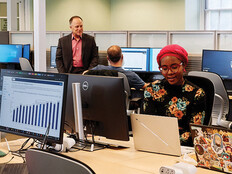Why the Successful Campus of the Future Will Rely on Collaboration Technology
Higher education campuses are becoming increasingly sophisticated from a technology perspective. This reflects the role of technology in education as it continues to become a more pervasive part of our lives. Passive learning in lecture halls and from physical textbooks is a thing of the past as institutions seek to support students and instructors in their quest to share ideas in more dynamic ways. At the same time, distance learning and online courses have become essential to many learners, and faculty are being asked to wear more hats and stay current on certifications as they maintain teaching duties.
As colleges seek to manage these changes, collaboration — both in person and through digital platforms — is becoming a key solution. Both students and faculty need collaboration tools that can address their needs within and between departments. And, since no two institutions are the same, solutions also need to deliver customization and connectivity to suit a variety of spaces and budgets.
MORE FROM EDTECH: See how digital learning platforms support content sharing in classrooms.
Collaboration Tools Are Key to Active-Learning Spaces
Many factors are driving the need for collaborative technology in higher education, but one of the biggest is the demand for collaborative learning spaces. Lecture halls, labs and even common areas are now expected to be technologically equipped and connected, largely through edge-to-cloud, with simple management, intuitive connectivity and device flexibility.
As students and faculty become accustomed to interactive technology for their personal use, they expect to see the same types of tools on campus. These tools must be easy to install and quick to set up, with intuitive interfaces and software that students and staff feel comfortable using right away. Popular systems include large, interactive displays that feature wireless connectivity, support for the apps that students and instructors already know, videoconferencing, and responsive touch technology for easy annotation and seamless idea sharing.
Collaboration technology must also be solutions-focused, integrating effectively with the various product ecosystems in place across campuses. This level of interoperability needs to be repeatable and sustainable, so that institutions can deploy solutions across the enterprise while ensuring that the unique needs of each room and department are met.
Collaboration displays benefit both instructors, who want to be able to annotate, whiteboard and save ideas seamlessly, and students, who want to easily share ideas in the classroom and in study sessions. Displays with integrated videoconferencing software, such as Zoom Rooms or Windows Collaboration Displays, can enhance courses, presentations, tutoring sessions and faculty meetings, benefitting student engagement and program development.
With the growing number of remote and distance learning students, collaboration technology such as displays and software can be a great way to keep students engaged and feeling like a part of the learning experience on campus. These tools also help colleges reduce travel expenses for guest speakers, who can visit a class via HD videoconferencing, and for faculty, who no longer have to travel for certifications and training.
Faculty face increasing demands to keep up with ongoing certifications required by state and federal organizations and from institutions themselves. Display technology is increasingly being used to give instructors easier access to required training courses from any location, saving both money and valuable time.
MORE FROM EDTECH: Learn how changing pedagogy and technology intersect on campus.
Using Collaboration Tools to Increase Student Engagement
While new collaboration features are beneficial, the most important factor is that solutions be intuitive and easy to use, and that they work seamlessly with existing tools and platforms.
Ease of use is critical for higher education installations where, even more than in an office setting, the people using the system may have various platform preferences and different levels of tech savvy. That’s one reason that display systems, which offer flexible features and the ability to customize applications and programs for specific fields, projects or curricula, are a good fit for the diverse environments on campus.
Conferencing tools such as Zoom, integrated into interactive whiteboard displays, can bring students together for group projects, study sessions or one-on-one learning with instructors and peers. Using these displays, instructors can easily teach as they would in an in-person setting, and remote students can ask questions and collaborate on projects.
This level of technology integration can change the way that remote and in-person students learn and reinforce a sense of connection to their studies.
As more institutions emphasize interactivity in pedagogy, collaboration displays and audiovisual technology will continue to be central to the learning experience. In addition, collaboration is a growing trend in workspaces: As institutions aim to prepare students for post-graduation careers, it’s important to give them hands-on experience with tools that they’ll find on the job. The best solutions are those that are easy to integrate, with all-in-one functionality that gives students and faculty a seamless user experience.









